I post this because before I unwillingly moved to HELLinois, I was a big part of the late night-bar scene. Bartending at The Tudor on Saturdays but also a well-known regular at many Downtown bars like The Continental, Mohawk Place, Backstage Pub - where I booked a LOT of shows, Pearl Street Grille - where for awhile I booked ALL the music, The Atomic - where I worked the door often. Even though most of the live music bars had moved out of downtown and were only in the burbs, I was downtown most nights. And I was in Allentown at some point every weekend. Nietchze's, The Jupiter Club and the Old Pink. A few times I'd been to Mulligans. My GF, Lynn and I would stop in at Buddies because she knew people there and eventually I got to know people there. Elmwood, too, was a regular stop during the week. Plus the show I hosted on Cable Access, Buffalo Rock Review!
I was a drinker, a big part of the local music scene and coming home after 4AM on Friday and Saturday nights was just part of my life.
I miss it. I miss it often and deeply, like I miss all of Buffalo where I was very ingrained in much of the city and it's events. It's one of my biggest regrets, walking away from a life that I deeply loved to end up old and fat and almost forgotten by everyone back home.

 buffalonews.com
buffalonews.com
As bartender Danny Pods opened Frizzy’s, a popular Allentown dive for cheap drinks, darts and pool for the Bills game last Sunday, flashing emergency vehicles barricaded part of the neighborhood to deal with the aftermath of an early-morning fire that decimated one of Frizzy’s neighbors, Mulligan’s Brick Bar. Brick Bar was next to the Old Pink, which burned down seven months ago. Two Allentown nightlife institutions are now rubble.
Frizzy’s quickly filled up with Brick Bar’s commiserating regulars.
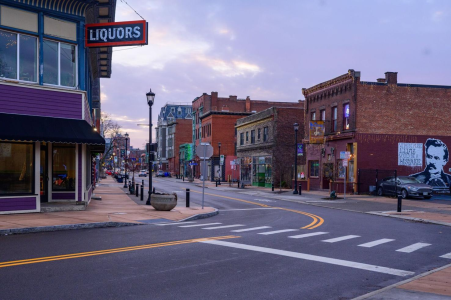
Allentown took a hit with the fires at the Old Pink and Brick Bar, but there also has been a flurry of new business in recent years.
“I don’t think Allentown could ever die,” said Danny Pods, a bartender at Frizzy’s on Allen Street. Joed Viera, Buffalo News
“What’s left? Nothing’s left,” Pods recalled a patron saying.
One of Buffalo’s oldest bars, Swannie House, closed in November after the death of its longtime owner, Tim Wiles. Mohawk Place, a 35-year-old downtown music venue for indie rock, punk and hardcore, is closing at the end of the month.
Fire, illness and death closed those iconic local bars, while something less sudden seems to be quelling another traditional piece of Buffalo’s nightlife scene: the 4 a.m. last call.
“More or less, the 4 a.m. crowd doesn’t exist anymore,” said Mark Supples, a bar industry veteran who founded the Pink, Mothers and House of Charm. “The Pink was about the last place left that was busier at 3 a.m. than they were at midnight.”
Young people drank less alcohol in 2024 than at any point over the last 20 years, according to national Gallup poll data, because of a growing concern with its negative health effects. Right before the pandemic in 2019, 65% of Americans ages 18 to 34 drank alcohol. Between 2021 and 2024, 59% of the same age group drank alcohol. Both of those numbers are way down from 2003 − when 72% of the age group drank alcohol. Young people now drink only slightly more often than their parents and grandparents. Fifty-eight percent of Americans who are 55 and older drink alcohol − a number that has remained constant since 2008. People who are 34 to 54 drink the most alcohol (69%), though that number is falling, too, down from 71% in 2019.
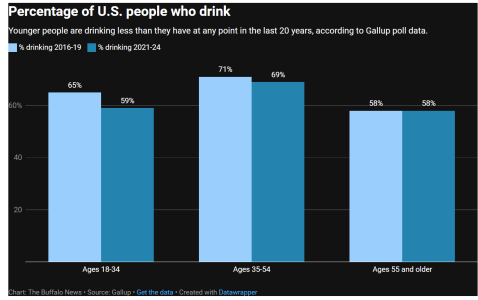
The U.S. surgeon general kicked off Dry January, a month when many Americans forgo drinking and reassess their relationships with alcohol, with new guidance that called alcohol the third leading preventable cause of cancer and recommended that Congress update alcohol warning labels to state its cancer risks.
At the same time, Americans are spending less time socializing than before the pandemic. In 2023, people between the ages of 25 and 34 spent 36 minutes per day, on average, socializing in person − more on weekends and less on weekdays. In 2019, the same age group spent 39 minutes per day socializing, according to the Bureau of Labor Statistics’ annual American Time Use Survey. The Atlantic, citing American Time Use data, recently nicknamed the 21st century as the “anti-social century.”
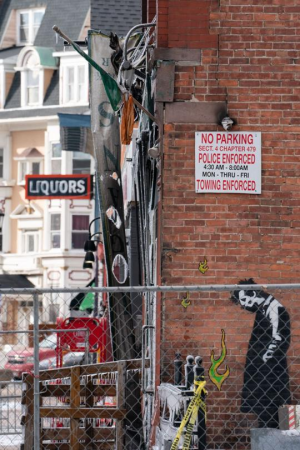
A look at the Mulligan's Brick Bar demolition site on Wednesday, Jan. 8, 2025. Joed Viera/Buffalo News
What is a bar, anyway? A place to hang out with your friends that you don’t have to clean; a spot to see and be seen; somewhere to drink, get tipsy and maybe more; a restaurant; a music venue; a site for Taylor Swift-bingo-karaoke-speed dating; an endangered species?
The latter might be an overstatement, but is it a business model that is becoming increasingly difficult to operate? Yes. Is it a place to loiter until 4 a.m.? Not so much, anymore.
Sky Bar, a 27-year-old rooftop club right off Chippewa Street, had between 1,700 to 2,000 customers on an average Saturday night in summer 2019, according to longtime manager Conor Hawkins. These days, Sky Bar is lucky if it swells with 300 to 500 people on a busy summer Saturday.
Sky Bar reduced its hours from 4 a.m. to 2 a.m. after the pandemic. Closing at 2 a.m. has its benefits − the staff gets to go home earlier and Hawkins said there’s less trouble – but he would keep it open until 4 a.m. if there was enough demand.
“Maybe socializing, going out and meeting people, is gonna be a thing of the past,” Hawkins said.
When Gabrielle Mattina opened the Gypsy Parlor in 2013, she stayed open until 4 a.m. every day of the week. Since Covid, Mattina reduced the hours to midnight most days, while still closing at 4 a.m. Thursday through Saturday.
“We’re still busy. There’s just not like a line out the door,” Mattina said. “I don’t think that there’s really a market for late-night places in Buffalo anymore.”
Buffalo is one of few cities nationwide that permits bars to serve alcohol until 4 a.m., though not the latest. (Some bars in Alaska go until 5 a.m.). Many bars reduced their hours when they reopened after pandemic shutdowns. Some still stay open until 4 a.m., at least on the weekends if it’s busy, such as Essex Street Pub, Frizzy’s and Mister Goodbar.
Josh Mullin, co-owner of Jack Rabbit in the Elmwood Village, chose to open the bar in 2021 with a 2 a.m. closing time. The lights would go up and partiers would shuffle out, dispersing to Mister Goodbar or Allentown for one or two last drinks. Now, the bar may stay open until 3 a.m. on a really crowded night, but Mullen believes in the platitude that “nothing good happens after 2.”
He still goes out a couple of nights a week, but mostly for events, such as raves and DJ sets at Black Dots, Duende, Jack Rabbit and No Fun Lo-Fi Bar, a record listening bar that opened last summer in the Elmwood Village. (If he does go to a neighborhood tavern, it’s Essex Street Pub, which has a lot of “cute girls.”)
If Jack Rabbit doesn’t have an event, DJ or band, “people will just generally go elsewhere,” Mullin said.
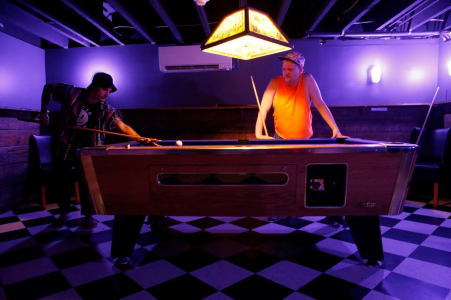
Geoff Kawalow, left, of Buffalo, and Mike Torpey of Rochester, hang out by the pool table at Jack Rabbit in the Elmwood Village. Buffalo News file photo
Covid added “extra stress and instability” to the bar scene, said Bobby Rapp, owner of Mister Goodbar, as has rising labor and product costs. Rapp has noticed that young people are drinking less, and since his eclectic and affordable dive needs to sell a lot of drinks to profit, he has been booking more DJs, live bands and comedians. Sales have recovered to pre-pandemic levels, but the makeup of sales has changed.
“It’s pretty much just [using] everything in our arsenal,” Rapp said. “To just get as many bites as we can on a nightly basis.”
Rapp thinks the shift in nightlife preferences are “just part of the constant evolution of the scene.”
He remembers when Chippewa Street burgeoned in the 1990s. Nine bars and restaurants opened in a two-year span between 1995 and 1997, according to Buffalo News archives, and the “Chip Strip,” formerly a red-light district, became the new mainstream nightlife hub, luring partiers from the rest of the city and the suburbs.
Some bar owners posit that customers aren’t just staying home, but closer to home, since the pandemic.
Black Smoke Bourbon Bar turns into a nightclub on weekend nights in the Village of Hamburg. By day, the bar makes elaborate cocktails with egg foam and cereal milk. By night, college kids swarm for DJ music. Its late-night success shocked co-owner Michael Maiorana when he opened in 2023. He expected to mostly sell whiskey cocktails, not High Noons to young 20-somethings pulling up in Ubers. He jumped on the opportunity to open a second bar and restaurant next door in November, the Nashville-themed Lassos Chicken & BBQ, to capture more of the nightlife scene. On a crowded weekend night, either bar may stay open until 2:30 a.m.
“People don’t have to go downtown to experience that,” Maiorana said.
It’s also not the first time that drinking habits have appeared to be down. In 2000, The Buffalo News reported that people in Buffalo were drinking less because of a shrinking, aging population and “more responsible drinking habits.” (The more responsible habits mentioned in the article were people choosing to have a “Belvedere martini and a couple of glasses of wine” instead of “10 or 12 cocktails” on a night out.)
Supples, however, doesn’t view the recent changes as a regular ebb and flow, even as he prepares to open a new bar in the downtown Theatre District in April.
“I don’t think it’s ever going to flow back to the way things were,” Supples said. “The critical mass probably isn’t ever going to reappear, but I still think that there’s plenty of opportunities in Buffalo, if you have a quality product and you treat people properly to be successful.”
Allentown took a hit with the fires at the Pink and Brick Bar, but there also has been a flurry of new business in recent years. The east end of Allen Street, which has long been a sanctuary for LGBTQ+ people, is flourishing with a new queer nightclub Twenty Six, that has been a hit since opening in 2023. Edison’s Proof and Provision resurrected another vacant queer bar space last year.
On Allen Street’s west end, Beacon Grille opened last summer and serves drinks and food until 2 a.m. on the weekends. Nietzsche’s is now under new ownership, comprising a group of musicians and longtime employees, who vow to make upgrades while keeping the bar’s musical heart beating – just not until 4 a.m.
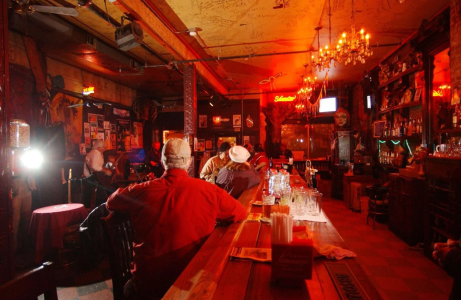
Nietzsche’s on Allen Street is now under new ownership, who vow to make upgrades while keeping the bar’s musical heart beating – just not until 4 a.m.
“The 4 a.m. crowd doesn’t exist anymore,” said Mark Supples, a bar industry veteran who founded the Pink, Mothers and House of Charm. Buffalo News file photo
“I don’t think Allentown could ever die,” Pods said. “I do think it’s just going to be kind of a changing period.”
I was a drinker, a big part of the local music scene and coming home after 4AM on Friday and Saturday nights was just part of my life.
I miss it. I miss it often and deeply, like I miss all of Buffalo where I was very ingrained in much of the city and it's events. It's one of my biggest regrets, walking away from a life that I deeply loved to end up old and fat and almost forgotten by everyone back home.

Buffalo's late-night bar scene was once a brand. Now? 'The 4 a.m. crowd doesn't exist anymore'
Fire, illness and death closed a few iconic local bars recently, but something less sudden seems to be quelling another traditional piece of Buffalo’s nightlife scene: 4 a.m. last call.
As bartender Danny Pods opened Frizzy’s, a popular Allentown dive for cheap drinks, darts and pool for the Bills game last Sunday, flashing emergency vehicles barricaded part of the neighborhood to deal with the aftermath of an early-morning fire that decimated one of Frizzy’s neighbors, Mulligan’s Brick Bar. Brick Bar was next to the Old Pink, which burned down seven months ago. Two Allentown nightlife institutions are now rubble.
Frizzy’s quickly filled up with Brick Bar’s commiserating regulars.

Allentown took a hit with the fires at the Old Pink and Brick Bar, but there also has been a flurry of new business in recent years.
“I don’t think Allentown could ever die,” said Danny Pods, a bartender at Frizzy’s on Allen Street. Joed Viera, Buffalo News
“What’s left? Nothing’s left,” Pods recalled a patron saying.
One of Buffalo’s oldest bars, Swannie House, closed in November after the death of its longtime owner, Tim Wiles. Mohawk Place, a 35-year-old downtown music venue for indie rock, punk and hardcore, is closing at the end of the month.
Fire, illness and death closed those iconic local bars, while something less sudden seems to be quelling another traditional piece of Buffalo’s nightlife scene: the 4 a.m. last call.
“More or less, the 4 a.m. crowd doesn’t exist anymore,” said Mark Supples, a bar industry veteran who founded the Pink, Mothers and House of Charm. “The Pink was about the last place left that was busier at 3 a.m. than they were at midnight.”
Young people drank less alcohol in 2024 than at any point over the last 20 years, according to national Gallup poll data, because of a growing concern with its negative health effects. Right before the pandemic in 2019, 65% of Americans ages 18 to 34 drank alcohol. Between 2021 and 2024, 59% of the same age group drank alcohol. Both of those numbers are way down from 2003 − when 72% of the age group drank alcohol. Young people now drink only slightly more often than their parents and grandparents. Fifty-eight percent of Americans who are 55 and older drink alcohol − a number that has remained constant since 2008. People who are 34 to 54 drink the most alcohol (69%), though that number is falling, too, down from 71% in 2019.

The U.S. surgeon general kicked off Dry January, a month when many Americans forgo drinking and reassess their relationships with alcohol, with new guidance that called alcohol the third leading preventable cause of cancer and recommended that Congress update alcohol warning labels to state its cancer risks.
At the same time, Americans are spending less time socializing than before the pandemic. In 2023, people between the ages of 25 and 34 spent 36 minutes per day, on average, socializing in person − more on weekends and less on weekdays. In 2019, the same age group spent 39 minutes per day socializing, according to the Bureau of Labor Statistics’ annual American Time Use Survey. The Atlantic, citing American Time Use data, recently nicknamed the 21st century as the “anti-social century.”

A look at the Mulligan's Brick Bar demolition site on Wednesday, Jan. 8, 2025. Joed Viera/Buffalo News
What is a bar, anyway? A place to hang out with your friends that you don’t have to clean; a spot to see and be seen; somewhere to drink, get tipsy and maybe more; a restaurant; a music venue; a site for Taylor Swift-bingo-karaoke-speed dating; an endangered species?
The latter might be an overstatement, but is it a business model that is becoming increasingly difficult to operate? Yes. Is it a place to loiter until 4 a.m.? Not so much, anymore.
What has become of 4 a.m.?
Buffalo’s citywide permission of a 4 a.m. last call has been at the center of debate for decades. Politicians seemed divided on the idea, but the group that appeared united behind the goal of keeping the party going until just before sunrise was the young customers.Sky Bar, a 27-year-old rooftop club right off Chippewa Street, had between 1,700 to 2,000 customers on an average Saturday night in summer 2019, according to longtime manager Conor Hawkins. These days, Sky Bar is lucky if it swells with 300 to 500 people on a busy summer Saturday.
Sky Bar reduced its hours from 4 a.m. to 2 a.m. after the pandemic. Closing at 2 a.m. has its benefits − the staff gets to go home earlier and Hawkins said there’s less trouble – but he would keep it open until 4 a.m. if there was enough demand.
“Maybe socializing, going out and meeting people, is gonna be a thing of the past,” Hawkins said.
When Gabrielle Mattina opened the Gypsy Parlor in 2013, she stayed open until 4 a.m. every day of the week. Since Covid, Mattina reduced the hours to midnight most days, while still closing at 4 a.m. Thursday through Saturday.
“We’re still busy. There’s just not like a line out the door,” Mattina said. “I don’t think that there’s really a market for late-night places in Buffalo anymore.”
Buffalo is one of few cities nationwide that permits bars to serve alcohol until 4 a.m., though not the latest. (Some bars in Alaska go until 5 a.m.). Many bars reduced their hours when they reopened after pandemic shutdowns. Some still stay open until 4 a.m., at least on the weekends if it’s busy, such as Essex Street Pub, Frizzy’s and Mister Goodbar.
Josh Mullin, co-owner of Jack Rabbit in the Elmwood Village, chose to open the bar in 2021 with a 2 a.m. closing time. The lights would go up and partiers would shuffle out, dispersing to Mister Goodbar or Allentown for one or two last drinks. Now, the bar may stay open until 3 a.m. on a really crowded night, but Mullen believes in the platitude that “nothing good happens after 2.”
What’s cool now?
Allentown resident Eric Oliverio, who was a 24-year-old grad student drinking at neighborhood “college bars” before the pandemic, found that he was less inclined to go to a dive bar to meet his friends for cheap beers when they reopened. Drinking started to matter less, but the activity started to matter more.He still goes out a couple of nights a week, but mostly for events, such as raves and DJ sets at Black Dots, Duende, Jack Rabbit and No Fun Lo-Fi Bar, a record listening bar that opened last summer in the Elmwood Village. (If he does go to a neighborhood tavern, it’s Essex Street Pub, which has a lot of “cute girls.”)
If Jack Rabbit doesn’t have an event, DJ or band, “people will just generally go elsewhere,” Mullin said.

Geoff Kawalow, left, of Buffalo, and Mike Torpey of Rochester, hang out by the pool table at Jack Rabbit in the Elmwood Village. Buffalo News file photo
Covid added “extra stress and instability” to the bar scene, said Bobby Rapp, owner of Mister Goodbar, as has rising labor and product costs. Rapp has noticed that young people are drinking less, and since his eclectic and affordable dive needs to sell a lot of drinks to profit, he has been booking more DJs, live bands and comedians. Sales have recovered to pre-pandemic levels, but the makeup of sales has changed.
“It’s pretty much just [using] everything in our arsenal,” Rapp said. “To just get as many bites as we can on a nightly basis.”
Rapp thinks the shift in nightlife preferences are “just part of the constant evolution of the scene.”
He remembers when Chippewa Street burgeoned in the 1990s. Nine bars and restaurants opened in a two-year span between 1995 and 1997, according to Buffalo News archives, and the “Chip Strip,” formerly a red-light district, became the new mainstream nightlife hub, luring partiers from the rest of the city and the suburbs.
Some bar owners posit that customers aren’t just staying home, but closer to home, since the pandemic.
Black Smoke Bourbon Bar turns into a nightclub on weekend nights in the Village of Hamburg. By day, the bar makes elaborate cocktails with egg foam and cereal milk. By night, college kids swarm for DJ music. Its late-night success shocked co-owner Michael Maiorana when he opened in 2023. He expected to mostly sell whiskey cocktails, not High Noons to young 20-somethings pulling up in Ubers. He jumped on the opportunity to open a second bar and restaurant next door in November, the Nashville-themed Lassos Chicken & BBQ, to capture more of the nightlife scene. On a crowded weekend night, either bar may stay open until 2:30 a.m.
“People don’t have to go downtown to experience that,” Maiorana said.
It’s also not the first time that drinking habits have appeared to be down. In 2000, The Buffalo News reported that people in Buffalo were drinking less because of a shrinking, aging population and “more responsible drinking habits.” (The more responsible habits mentioned in the article were people choosing to have a “Belvedere martini and a couple of glasses of wine” instead of “10 or 12 cocktails” on a night out.)
Supples, however, doesn’t view the recent changes as a regular ebb and flow, even as he prepares to open a new bar in the downtown Theatre District in April.
“I don’t think it’s ever going to flow back to the way things were,” Supples said. “The critical mass probably isn’t ever going to reappear, but I still think that there’s plenty of opportunities in Buffalo, if you have a quality product and you treat people properly to be successful.”
Allentown took a hit with the fires at the Pink and Brick Bar, but there also has been a flurry of new business in recent years. The east end of Allen Street, which has long been a sanctuary for LGBTQ+ people, is flourishing with a new queer nightclub Twenty Six, that has been a hit since opening in 2023. Edison’s Proof and Provision resurrected another vacant queer bar space last year.
On Allen Street’s west end, Beacon Grille opened last summer and serves drinks and food until 2 a.m. on the weekends. Nietzsche’s is now under new ownership, comprising a group of musicians and longtime employees, who vow to make upgrades while keeping the bar’s musical heart beating – just not until 4 a.m.

Nietzsche’s on Allen Street is now under new ownership, who vow to make upgrades while keeping the bar’s musical heart beating – just not until 4 a.m.
“The 4 a.m. crowd doesn’t exist anymore,” said Mark Supples, a bar industry veteran who founded the Pink, Mothers and House of Charm. Buffalo News file photo
“I don’t think Allentown could ever die,” Pods said. “I do think it’s just going to be kind of a changing period.”
Last edited:
